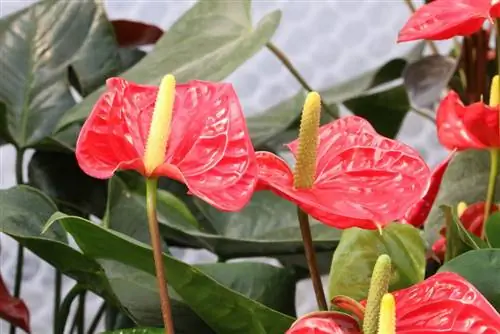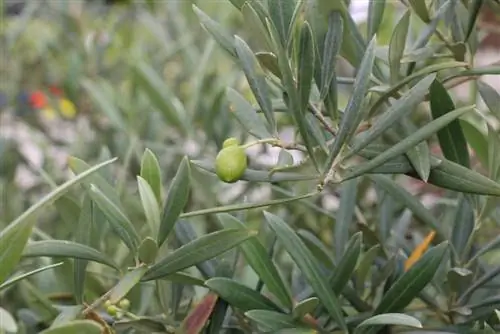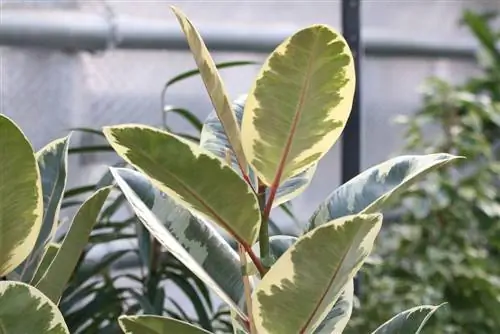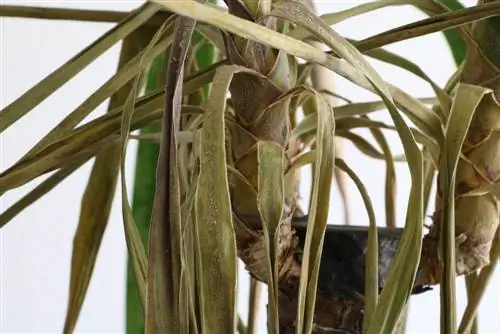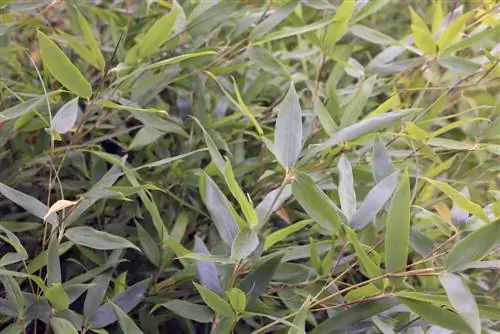- Author admin [email protected].
- Public 2023-12-17 03:39.
- Last modified 2025-01-24 12:45.
Almost exclusively hybrid plants are available in stores. Flamingo flowers are a little more demanding to care for than other flowering plants, but the culture can be successful if a few things are taken into account.
Short profile of the anthuriums
- Also called sulfur flower or candytuft
- Maple Family
- 600 to 1,000 species
- evergreen, perennial plant
- The actual flower sits in the shape of a flask on a red, white or pink bract
- Comes mainly from the rainforests of South and Central America
- Flowering period there from February to May
- Flowering possible all year round if kept indoors
- Depending on the variety, it grows to a height of 30 to 80 cm
- Vivid green, leathery and lanceolate leaves
- Forms berries as fruit
Important:
Anthuriums are slightly poisonous. They should not be consumed. Gastrointestinal complaints, nausea, nausea and diarrhea can occur. Upon contact with the skin or mucous membranes, redness may occur, the skin tends to form blisters, increased salivation may occur and pain in the mouth may occur. The symptoms usually subside after one to two hours. Anthuriums are not ideal for plant lovers with small children and pets.
What to do if anthuriums are sick?
If anthuriums have a suitable location and are in a good substrate, they develop well and delight with numerous, decorative flowers. However, the water and nutrient supply must also be correct. Anthuriums are shade plants, but require sufficient light. Sun, especially midday sun, causes burns on the leaves. The plants appreciate temperatures between 18 and 20°C and high humidity. The soil should be extremely permeable to air and water. A high proportion of acidic soil is ideal. What flamingo flowers cannot tolerate are dryness, wetness and limescale. Unfortunately, it is quite common for flamingo flowers to develop brown or yellow leaves. This can have a variety of causes. This needs to be investigated so that the “error” can be corrected. Common causes are incorrect lighting conditions, too low humidity, a container that is too small or even pests. Even plant diseases can be to blame.
Causes of yellow and brown spots and leaves on the anthurium
There are various causes of discoloration of leaves:
Wrong lighting conditions
Flamingo flowers are rainforest plants. They thrive there on the ground, but also as epiphytes on trees. Rarely does a ray of sunlight stray all the way down, although there is plenty of light shining through the leaves. Anthuriums need plenty of light, not only in summer but also in winter. Nevertheless, you should not expose them to the blazing sun, neither outdoors nor behind a window. Burns, brown spots or streaks quickly appear on the leaves. Sometimes the entire leaf turns brown. These burns do not go away, like sunburn in humans. East or west windows are favorable; a so-called flower window is ideal.
- Need a lot of light
- Summer and Winter
- Not in the sun
- Not even behind glass
- In winter, a plant lamp helps to improve poor lighting conditions
Inappropriate plant substrate
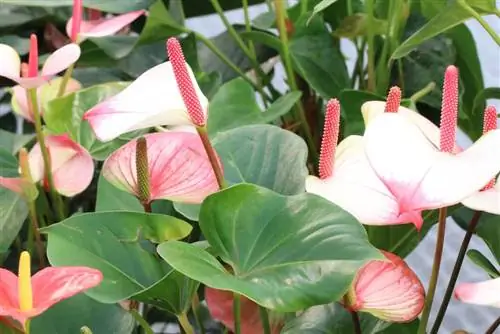
No matter what plant substrate is used, there must be drainage at the bottom of the container. It is important that the water does not build up. If water collects in the root area, root rot occurs. This is usually only recognized when it is too late to save the anthurium. The substrate itself must be very permeable to water and air. It should also have an acidic pH value. Orchid soil or a mixture of coarse peat, compost soil and coarse sand, in approximately equal parts, is suitable. If you only have normal potting soil available, you should definitely make it more permeable, e.g. with polystyrene beads.
- Drainage in the vessel
- No waterlogging
- Water and air permeable substrate
- Acidic pH
Incorrect watering behavior
Many plant lovers think their plants are too good when watering. They “drown” them. Flamingo flowers cannot tolerate constant moisture. But dryness isn't their thing either. The plants are a bit tricky. In order to stay he althy and be able to produce flowers, an evenly moist soil is ideal. When the leaves are constantly wet, changes occur quite quickly. They turn yellow and brown over time and die. The same thing can happen if the flamingo flower is not watered enough. If there is insufficient water supply, individual leaves die, first turn yellow and then wilt and brown.
- Even, slightly moist substrate
- Don’t let it dry out
- Don't keep it wet all the time
Tip:
Anthuriums don't like lime. This changes the pH value of the soil. Therefore you should not water with tap water. Rainwater is best suited.
If the anthurium is cooler when it is dormant, watering must be restricted. At lower temperatures, not as much water is needed. The cooler the temperatures, the less water should be added.
Water less when vegetation is dormant in cool temperatures
High humidity is important for good growth. This can be achieved in different ways. The easiest way is to spray the plant regularly with rainwater. However, it is important not to spray the flowers or the colored bracts of the anthurium. However, the planter can also be placed in a bowl of water, but on stones so that it is above the surface of the water. The water in the bowl evaporates, creating higher humidity.
- Spray plants regularly
- Use rainwater
- Do not spray on flowers
- Place humidifier next to the plants
Incorrect fertilization
If there is too much fertilizer or the wrong composition, leaf spots and discoloration of the leaves can also occur. During the growing season, i.e. between spring and autumn, fertilization is carried out every two weeks. Liquid fertilizer is suitable, but in the lowest possible concentration. Do not fertilize during the dormant period.
Pest Infestation
Pests can also cause the leaves of the anthurium to turn yellow and brown and ultimately die. Spider mites in particular are true masters of damaging plants. They are often discovered too late and have already multiplied en masse. They are then difficult to combat and the chemical agents also damage the plants. If the leaves become lighter and appear translucent, this may indicate spider mites. It is best to spray the plant with a fine mist of water. If small webs then appear to which the droplets get stuck, the pests have been exposed. Spider mites are so tiny that they can only be seen under a microscope. The insects pierce the anthurium and suck the sap. They damage plants simply because of their mass. They weaken them and make them susceptible to disease. If the infestation is small, it is sometimes enough to simply increase the humidity. Spider mites don't like that. But if they have already spread, the only thing that can help is chemical treatment. Here you should inquire about the most effective remedy. Spider mites are resistant to many agents, which makes combating them so difficult.
- Spider mites can be recognized by their web-like structures
- When sprayed with water, drops form on it
- Hard to fight
- Increase humidity
- Chemical agents
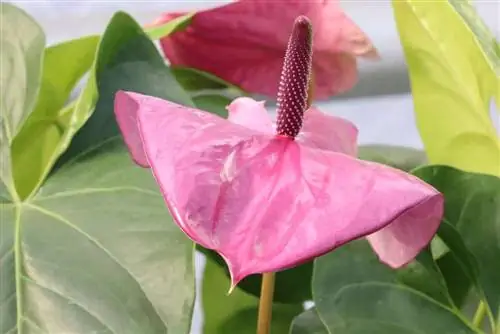
Scale insects are just as harmful and difficult to control. They also feed on plant sap, but also damage the flamingo flower with their excretions. Sooty mold fungi tend to settle on the so-called honeydew, which weakens the plants. Scale insects are often difficult to recognize. They sit flat on the stems and under leaves and are usually only noticed when the sticky excretions appear on the ground. By then the pests have usually multiplied significantly and caused quite a bit of damage. They should be de alt with immediately. You can wipe them off with a toothpick or something similar, but you'll never get them all that way. Often only chemical control helps here.
- Scale insects can be recognized by small brown bumps on stems and under leaves
- Hard to fight
- Collection or chemical club
Diseases
When it comes to diseases, it is primarily leaf spot that causes problems for anthuriums. Brown spots with a yellow halo form. A black border can often be seen.
Incorrect overwintering
Anthuriums have different requirements in winter than in summer. The plants want to be bright, so they need a lot of light, but the temperatures should be lowered for about 7 to 8 weeks. 15°C would be ideal. Watering is only carried out when the top layer of soil has dried thoroughly. However, the root ball must not dry out completely. Fertilizer is completely avoided during the dormant phase. You have to be careful that the anthuriums can cope with the dry heating air. They have a hard time with that. That's why daily spraying is important. But there are several ways to increase the humidity.
- Put in a cooler, about 15°C
- Lots of light, but no sun
- Water less
- Do not fertilize
Conclusion
Anthuriums are wonderful flowering plants, but they are a bit tricky to care for. They have a number of requirements, mainly regarding location, planting substrate, light and watering. A cooler location in winter is also important. Only if all these things are taken into account will the anthurium develop and produce many flowers. They are not beginner plants. Anyone who has a feeling for plants will get along.

